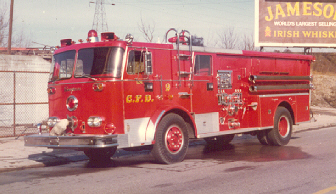Winnebago's of the C.F.D. |
|
by Steve Hagy |
|
Civil disturbances hit the streets of Cincinnati in 1967 and 1968. In addition to burning and looting, firefighter lives were endangered while responding to alarms and on the scene of emergencies. Rocks, bottles, and gunfire were directed at Cincinnati's bravest.
|
|
Fire Chief Bert Lugananni thought that there should be a better way to protect the city's firefighters. The current apparatus on the roster afforded little protection while responding to an alarm. Most of the aerials had open crew and tiller compartments. The engine companies had better protection with enclosed cabs, but the jump seat areas on the new cab forward engines and trucks delivered in 1967 and 1968 still left personnel vulnerable to attack.
| 
|
 |
Fully enclosed fire apparatus was not a new idea. Charlotte, North Carolina purchased an enclosed pumper from Mack Fire Apparatus Company in 1935. Seagrave built dozens of pumpers and rescue rigs from 1936 through the 1960's that were of a similar design to the 52's apparatus.
Squad 52 was still operating with a 1942 Seagrave heavy rescue truck. This vehicle was fully enclosed with the entire crew riding inside the rig. Chief Lugananni thought that apparatus of a similar design would increase firefighter safety. |
After purchasing 5 standard, cab forward pumpers from American LaFrance in 1970 new specifications were prepared for engine and truck company apparatus for the C.F.D. The new rigs would be cab forward, enclosed pumpers and aerials.
The engines would have a pre-piped, roof mounted deck gun. Access to the roof area would be through ladders permanently mounted on each side of the rig between the 2 doors. Unlike traditional 4-door cab apparatus, the roof on these rigs would extend over the hose bed to afford protection to anyone that might be riding the tailboard. A 1000 gpm pump and 300 gallon booster tank was specified. |
|
Delivery of these newly styled machines began in the summer of 1972. Boasting a sleek, streamlined appearance, they were top of the line, modern apparatus that any department could be proud of. The initial assignments of these rigs were to Engine Companies 9, 19, 29, and 32.
On April 14, 1973, the safety and stability of Engine 29's rig was put to a severe test. Dispatched to an alarm at 3:39 a.m. for the Interstate Bakery, the pumper was involved in an accident after a motorist ran the red light at the intersection of 8th and Linn streets. All five members of the 29's walked away from the accident with minor injuries while the driver of the car was killed in the accident. The 29's rig ended up rolled onto the drivers side and was damaged beyond repair. After the accident the almost new Seagrave was sent to the municipal garage so that it could be cannibalized for parts. Four additional enclosed pumpers of the new design had been ordered by this time. After the accident, the pumper order was increased to 5 rigs. The 1974 deliveries were initially assigned to Engines 17, 29, 31, 46, and 48. The pumpers delivered in 1974 differed from the 1972 delivery in that they had high-side compartments on the driver's side, as hard suction hose was no longer being specified on new apparatus. | 
|
The last delivery of these fully enclosed rigs occurred in 1975. Engines 5, 8, 20, and 24 were assigned new pumpers. In all, 13 engines of this style were delivered to the C.F.D.
Opinions about apparatus abound. Most of the comments that I ever heard about these rigs were positive. The one drawback on the engines was that loading hose could be tough, especially if you were larger than average in size.
|
|
 |
I stopped at Engine 19 one day to take a look at their rig and get a picture. When I asked the officer of the 19's if the rig could be parked on the ramp for the photo, he said "Sure, you want a picture of the Winnebago". That was the first time that I had heard that name applied to these rigs, but it was a name that obviously had stuck with the roughnecks! In the almost 30 years that have passed since the first of these unique rigs was delivered, the name Winnebago has stuck for those pumpers. The engines were so distinctive that everyone knows exactly what type of apparatus you're referring to when you use the "W" word.
|
One interesting side note is that Cincinnati was not the only department to operate a Winnebago. Lawrenceburg, Indiana received a 1976 Seagrave with a 1500 gpm pump and 500 gallon tank. This was the only other rig of this style constructed.
|
|
 |
|
Unfortunately time, and the monthly municipal auctions, brought an end to the Winnebago's. I'm not aware of any of these rigs that have survived. I've always wondered though, how would one of those pumpers look painted white and with a big brown W and a line going down the side....
|
|
Photos - Steve Hagy